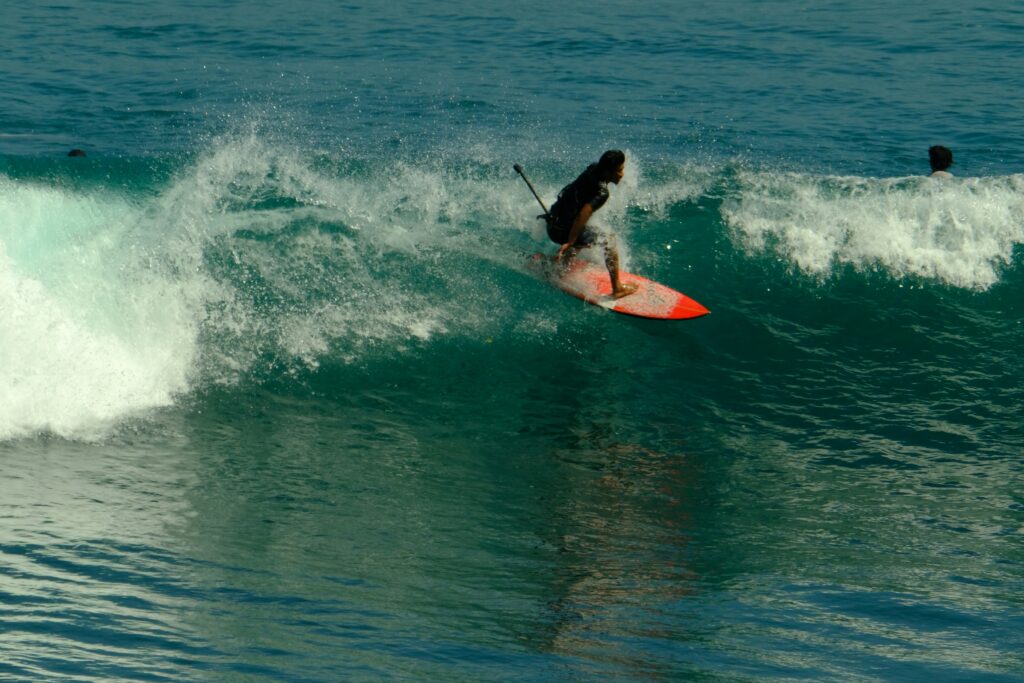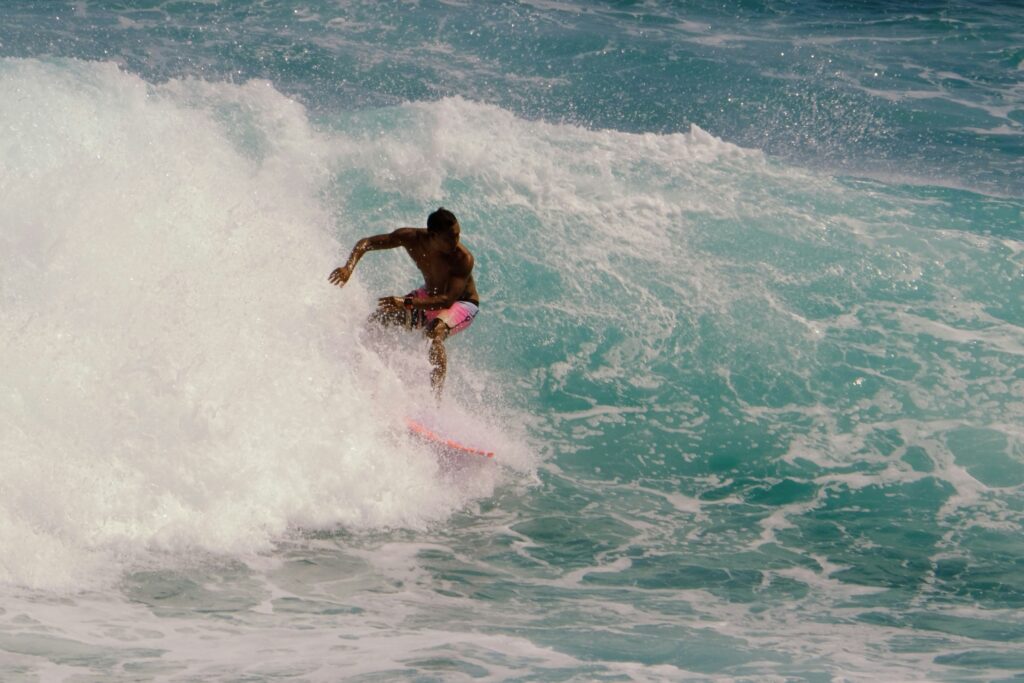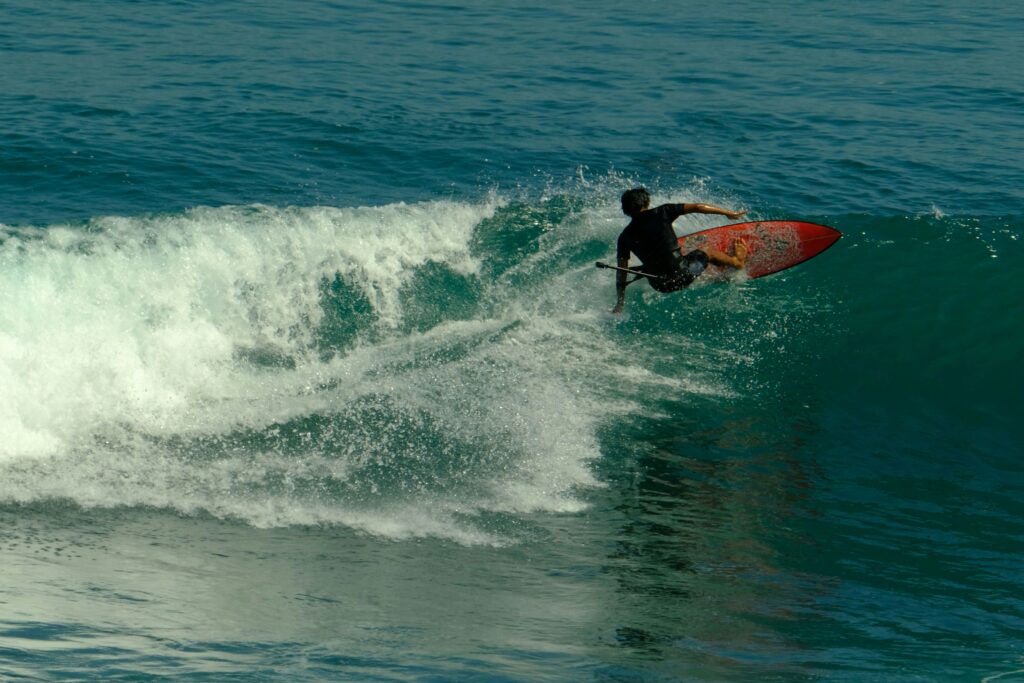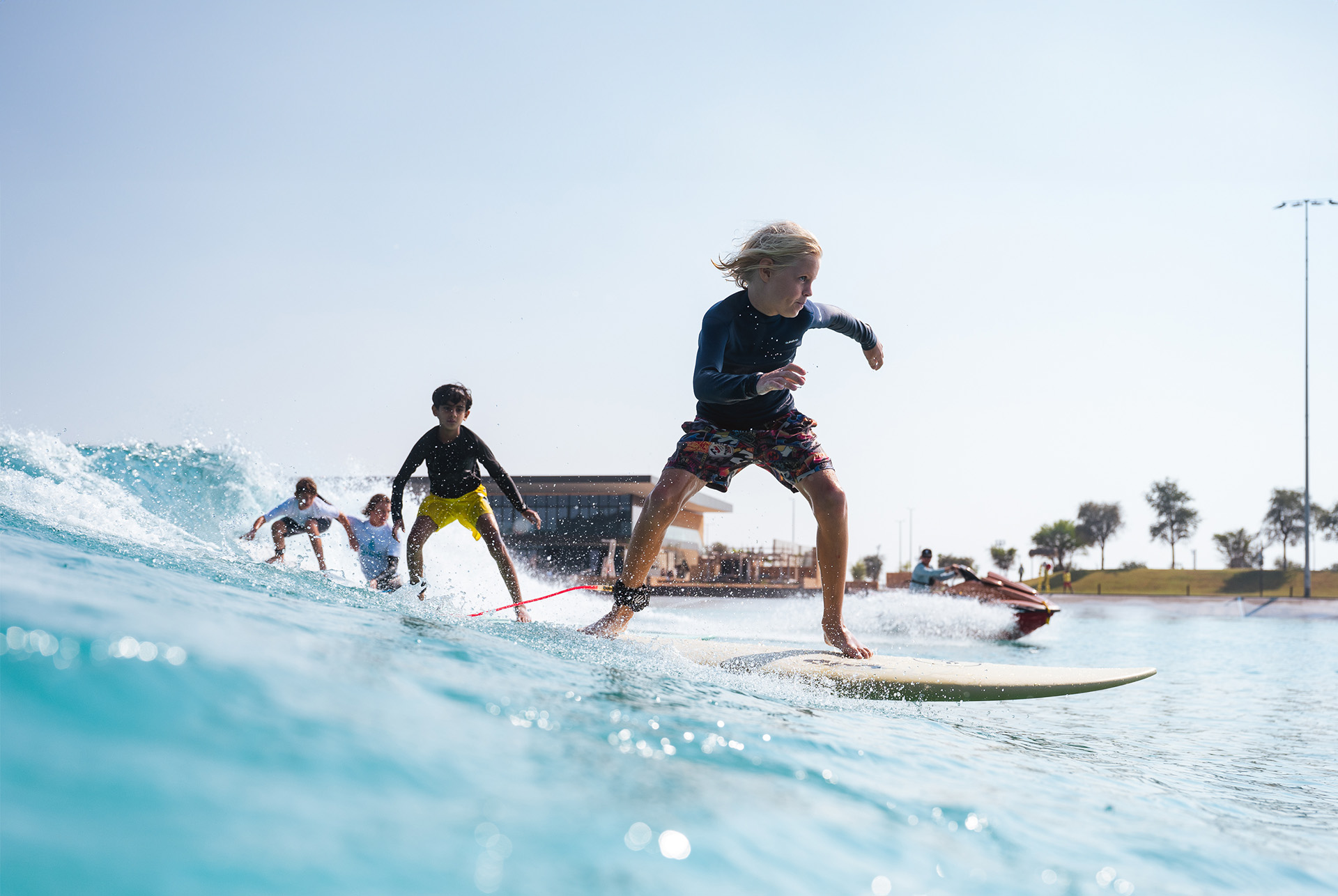Bali, Indonesia, is not just a tropical paradise of stunning beaches and lush landscapes; it’s a global hotspot for surfing enthusiasts.
With its world-class waves, warm waters, and a vibrant surf culture, the island has earned its place as one of the top surfing destinations on the planet.
Whether you’re a seasoned pro or a beginner looking to catch your first wave, Bali offers something for every skill level and expertise.
From the legendary breaks of Uluwatu and Padang Padang to the mellow waves of Kuta and Canggu, the island is a haven for surfers seeking adventure, beauty, and unforgettable rides.
With a year-round surf season and breathtaking ocean views, Bali is truly a surfer’s dream come true. Therefore, you can call it a paradise for wave riders.
To enjoy a trip to Bali and surf its fines waves, we made this blog for you as we cover the best surfing spots in Bali with a lot more information that allow you to navigate throughout the island.
Thus, stick around to find out where you can surf in Bali and what makes it a surfing paradise that people from all over the world attend to visit.

When Is The Best Time To Surf In Bali?
The best time to surf in Bali largely depends on the type of waves you’re seeking and your skill level. However, the island’s prime surf season generally falls between May and September, during the dry season.
During this period, the western coastline of Bali, particularly spots like Uluwatu, Padang Padang, and Canggu, experiences consistent offshore winds and big swells, making it ideal for experienced surfers chasing world-class waves in the best beaches of Bali.
If you’re a beginner, the wet season from November to March might be more suitable, as the surf is mellower, especially on the East Coast in spots like Sanur and Nusa Dua.
While the wet season brings rain, the waves are more forgiving, making it a good time to practice and improve your skills.
The tropical climate of Bali ensures year-round warm water, so you can surf comfortably at any time of year, depending on the conditions you’re after!
For more information about this tropical paradise, we already have a blog post about the best time to visit Bali. Thus, you can choose your perfect season to surf in Bali.
Can You Surf In Bali?
The answer to the question “can you surf in Bali?” should be obvious by now as we already answered it indirectly, but let me tell you that Bali is one of the most famous surfing destinations in the world.
The island is renowned for its consistent waves, warm waters, and a wide variety of surf spots that cater to all skill levels. Whether you’re a beginner or an advanced surfer, Bali has something for everyone.
Where Can You Surf In Bali? The Best Surfing Spots In Bali:
Let me introduce you to the top 10 surf spots in Bali that are classified from easy (beginner level) to hard (intermediate level). They are equipped with detailed information on the type of surf, the best season and the spots’ hazards.
Where can you surf in Bali?, you might ask. Bali offers an incredible variety of surfing spots, ranging from beginner-friendly beaches to world-class reef breaks for pros. Here are some of the best surfing spots in Bali:

1. Gado-Gado:
Gado-Gado is a lesser-known place, but a popular surf spot. Located in Seminyak near the busy beachfront area, Gado-Gado is ideal for surfers who want to avoid the crowds of nearby Kuta but still can enjoy great waves.
Surf Conditions at Gado-Gado:
- Level: Intermediate to Advanced
- Wave Type: Left and right-hand beach break
- Best Time to Surf: May to September (dry season)
- Wave Size: Typically 3–6 feet, but can get bigger on good days
- Tide: Works best on mid to high tide
Surf Experience:
Gado-Gado offers consistent beach break waves with both left and right-handers, making it a versatile spot for surfers looking for variety.
While the waves here can be powerful at times, it’s more forgiving than some of Bali’s famous reef breaks, which makes it suitable for intermediate surfers who are comfortable with slightly larger waves.
The beach is relatively less crowded compared to other surf spots like Kuta or Uluwatu, giving surfers a bit more room to maneuver.
The Seminyak area surrounding Gado-Gado also offers excellent beachfront cafés and restaurants for relaxing after a surf session. Therefore, you can visit our blog on what to eat in Bali to take a break from surfing.
Amenities:
Surf Schools and Rentals:
- Several surf schools provide lessons for all skill levels, from beginners to advanced surfers. They also rent out surfboards and other equipment.
- Notable schools include Odyssey Surf School and Rip Curl School of Surf.
Beach Clubs and Cafés:
- Gado Gado Beach has numerous beach clubs and cafés where you can relax, enjoy a meal, and grab refreshments. Some popular spots include Gado Gado Restaurant and La Plancha.
- Many establishments have sun loungers and umbrellas for rent, enhancing your beach experience.
Changing Facilities:
- Some beach clubs offer changing rooms and showers for rinsing off after surfing.
Lifeguards:
- Lifeguard services are typically available, ensuring a safer surfing experience.
2. Kuta Beach:
Kuta Beach is one of the most famous and accessible surf spots in Bali, renowned for its vibrant atmosphere, consistent waves, and bustling nightlife.
It’s often considered the starting point for many surfers, making it a prime destination for both beginners and seasoned riders. Here’s what you need to know about surfing in Kuta:
Surf Conditions at Kuta:
- Level: Beginner to Intermediate
- Wave Type: Beach break
- Best Time to Surf: Year-round, but especially during the dry season from May to September.
- Wave Size: Typically ranges from 2 to 6 feet, depending on the season and swell.
- Tide: Works best on mid to high tide.
Surf Experience:
Kuta Beach offers a sandy bottom and mellow waves, making it an ideal location for beginners to learn and practice their skills.
Many surf schools operate along the beach, providing lessons and equipment rentals for those looking to catch their first wave. The atmosphere is lively, with plenty of surfers and beachgoers creating a fun and energetic vibe.
For more experienced surfers, Kuta can still provide enjoyable sessions, especially during bigger swells. The beach can get crowded, particularly during peak tourist season, but the variety of waves and the vibrant beach culture make it an exciting spot.
Amenities:
Kuta Beach is well-equipped with numerous amenities, including:
- Surf schools and rental shops: Offering boards, wetsuits, and professional instructors for all levels.
- Beachfront cafes and restaurants: Perfect for relaxing after a surf session, many places offer delicious local and international cuisine.
- Nightlife: Kuta is known for its lively nightlife, with numerous bars and clubs lining the beachfront.
3. Old Mans:
Old Man’s is one of the most popular surf spots in Canggu, Bali, known for its laid-back vibe, excellent waves, and vibrant beach culture.
It’s a favorite among both locals and tourists, making it a must-visit for surfers looking to enjoy a fun day on the water. Here’s what you need to know about surfing at Old Man’s:
Surf Conditions at Old Man’s:
- Level: Beginner to Intermediate
- Wave Type: Beach break
- Best Time to Surf: Year-round, but the dry season from May to September is ideal.
- Wave Size: Typically ranges from 2 to 6 feet, but can be larger during big swells.
- Tide: Works best on mid to high tide, although it can also be surfed at low tide.
Surf Experience:
Old Man’s is known for its consistent waves, making it a great spot for beginners to learn and practice their skills.
The sandy bottom and relatively mellow surf conditions provide a safe environment for those just starting out. Many surf schools are located nearby, offering lessons and board rentals.
For intermediate surfers, Old Man’s offers fun, fast waves with both left and right-handers, making it a versatile spot for different surfing styles. The atmosphere here is friendly and relaxed, with a community of surfers sharing waves and tips.
Amenities:
The Old Man’s beach area is equipped with several amenities, including:
- Surf schools and rental shops: Providing boards, wetsuits, and lessons for all levels.
- Beachfront bar and restaurant: Known for its laid-back vibe, it’s a great place to unwind after a surf session with food, drinks, and live music.
- Facilities: Showers and restrooms are available, making it convenient for surfers to clean up after their session.
4. Berawa:
Berawa Beach, located in the trendy area of Canggu, Bali, has gained popularity among surfers for its consistent waves, beautiful scenery, and relaxed vibe.
It’s a fantastic surfing spot for both beginners and experienced surfers, making it a go-to destination for those looking to enjoy the surf culture of Bali. Here’s what you need to know about surfing at Berawa:
Surf Conditions at Berawa:
- Level: Beginner to Intermediate
- Wave Type: Beach break
- Best Time to Surf: May to September (dry season) for the best swells; however, it can be surfed year-round.
- Wave Size: Typically ranges from 2 to 6 feet, depending on the season and swell conditions.
- Tide: Works best on mid to high tide, but can also be surfed at low tide.
Surf Experience:
Berawa Beach is known for its long, rolling waves, which are perfect for beginners learning to surf. The sandy bottom and gentle waves provide a safe environment for newcomers to practice.
There are several surf schools and rental shops along the beach, making it easy for beginners to find lessons and equipment.
For intermediate surfers, Berawa offers more challenging sections, especially during bigger swells when the waves can become more powerful. The beach features both left and right-hand waves, allowing for a varied surfing experience.
Amenities:
Berawa Beach is well-equipped with amenities, including:
- Surf schools and rental shops: Offering lessons, board rentals, and other surf-related services for all skill levels.
- Beachfront cafés and restaurants: A variety of dining options are available, ranging from local Indonesian cuisine to international dishes, perfect for relaxing after a surf session.
- Facilities: Showers and restrooms are available for convenience.
5. Serangan:
Serangan Beach, also known as Turtle Island, is a popular surf destination located on the southeastern coast of Bali, just a short drive from the bustling areas of Kuta and Seminyak.
This spot is known for its consistent waves and is favored by both local surfers and visitors. Here’s what you need to know about surfing at Serangan Beach:
Surf Conditions at Serangan:
- Level: Beginner to Intermediate
- Wave Type: Beach break and reef break
- Best Time to Surf: May to September (dry season), but it can be surfed year-round.
- Wave Size: Typically ranges from 2 to 6 feet, with bigger swells possible during peak season.
- Tide: Works best on mid to high tide, although it can be surfed at various tides depending on conditions.
Surf Experience:
Serangan offers a mix of beach and reef breaks, making it suitable for surfers of different skill levels. The sandy bottom provides a safe environment for beginners, while the more advanced reef sections offer exciting waves for those looking to improve their skills.
The waves at Serangan can be quite consistent, particularly during the dry season, with clean swells and good conditions.
The area is less crowded than some of Bali’s more famous surf spots, allowing for a more relaxed surfing experience.
Amenities:
Serangan Beach is equipped with several amenities, including:
- Surf schools and rental shops: Various options are available for beginners looking for lessons and equipment rentals.
- Beachfront warungs (local eateries): Offering delicious Indonesian food and refreshments to enjoy after a surf session.
- Facilities: Some basic amenities, such as showers and restrooms, are available near the beach.

6. Medewi:
Medewi Beach, located on the western coast of Bali, is a hidden gem known for its long left-hand point break and relaxed atmosphere.
It’s a fantastic destination for surfers looking to escape the more crowded beaches and enjoy a unique surfing experience. Here’s what you need to know about surfing at Medewi:
Surf Conditions at Medewi:
- Level: Beginner to Intermediate
- Wave Type: Left-hand point break
- Best Time to Surf: May to September (dry season) for the best swells, but it can be surfed year-round.
- Wave Size: Typically ranges from 3 to 8 feet, with larger swells possible during peak season.
- Tide: Works best on mid to high tide, but it can also be surfed at low tide, depending on conditions.
Surf Experience:
Medewi is famous for its long, mellow left-hand waves, making it an ideal spot for beginners and longboarders.
The waves are known for their consistency and are perfect for practicing turns and maneuvers. The sandy bottom and gentle swells create a safe environment for those just starting out.
For intermediate surfers, Medewi offers a unique experience with longer rides and more opportunities to practice skills. The point break can provide fun, fast waves, especially when the conditions are right.
Amenities:
Medewi Beach has a laid-back vibe and is equipped with several amenities, including:
- Surf schools and rental shops: Offering lessons and board rentals for beginners and intermediate surfers.
- Beachfront warungs (local eateries): Serving delicious Indonesian food and refreshments, perfect for relaxing after a surf session.
- Basic facilities: Showers and restrooms are available for convenience.
7. Balangan:
Balangan Beach, located on the Bukit Peninsula in southern Bali, is a beautiful and renowned surf spot known for its picturesque cliffs, white sand, and consistent left-hand reef break.
It’s a favorite among intermediate and advanced surfers, offering challenging and exciting waves. Here’s a breakdown of what to expect when surfing at Balangan:
Surf Conditions at Balangan:
- Level: Intermediate to Advanced
- Wave Type: Left-hand reef break
- Best Time to Surf: May to September (dry season) when the offshore winds create ideal conditions.
- Wave Size: Typically ranges from 3 to 8 feet, with larger swells during peak surf season.
- Tide: Works best on mid to high tide; low tide can expose the sharp reef, making it riskier for beginners.
Surf Experience:
Balangan is famous for its powerful, long left-hand waves that peel consistently along the reef. It’s one of Bali’s top spots for intermediate to advanced surfers looking for a challenge, as the waves can get quite fast and hollow, providing thrilling rides.
While the reef is sharp, making it more suitable for experienced surfers, intermediates who are comfortable navigating reef breaks can still enjoy the consistent waves.
On smaller swell days, longboarders can also find fun, smooth rides. The scenic backdrop of limestone cliffs adds to the charm, making each surf session here feel special.
Amenities:
Balangan Beach offers a laid-back, rustic atmosphere with a few local amenities:
- Surfboard rentals and schools: There are a few rental shops and surf schools, but it’s best suited for those with some surfing experience.
- Beachfront warungs (local eateries): These simple cafes offer Indonesian food and drinks, perfect for relaxing after a surf session.
- Basic facilities: Showers and restrooms are available, but they are relatively basic compared to more developed beaches.
8. Nusa Dua:
Nusa Dua, known for its luxurious resorts and pristine beaches, also offers some excellent surfing opportunities. It may not be as famous as other surf spots in Bali, such as Kuta or Uluwatu.
However, Nusa Dua has its own unique charm and is worth exploring for surfers looking for a different experience. Here’s what you need to know about surfing in Nusa Dua:
Surf Conditions at Nusa Dua:
- Level: Intermediate to Advanced
- Wave Type: Reef break and beach break
- Best Time to Surf: May to September (dry season) for the most consistent swells, but it can be surfed year-round.
- Wave Size: Typically ranges from 3 to 8 feet, depending on the season and swell.
- Tide: Works best on mid to high tide for most breaks, although some sections can be surfed at low tide.
Surf Experience:
Nusa Dua features several surf spots, with varying conditions suitable for different skill levels. The main surf breaks include:
One of whom is the Geger Beach, which is known for its left-hand and right-hand reef breaks. It’s best for intermediate to advanced surfers. The waves can be powerful and fast, especially during larger swells.
Another surfing spot is the Nusa Dua Beach. It offers a more mellow beach break that can be suitable for beginners when conditions are right. This area is generally less crowded, allowing for a more relaxed surfing experience.
Finally, the point at Nusa Dua, which offers a longer ride for more experienced surfers, particularly on bigger swells. The takeoff can be steep, so it’s recommended for those who are comfortable with reef breaks.
Amenities:
Nusa Dua is well-equipped with amenities, making it a comfortable place for surfers to spend the day:
- Surf schools and rentals: Several surf schools and rental shops are available for beginners and intermediate surfers looking for lessons or equipment.
- Resorts and beachfront cafés: Enjoy a meal or drink after your surf session at one of the many upscale resorts or local eateries in the area.
- Facilities: Well-maintained restrooms and showers are available at many beaches.
9. Padang Padang:
Padang Padang Beach, often referred to simply as Padang Padang, is one of Bali’s most iconic surf spots, known for its stunning scenery and world-class waves.
Located on the Bukit Peninsula, this beach is famous for its powerful and challenging surf breaks, making it a favorite among experienced surfers. Here’s what you need to know about surfing at Padang Padang:
Surf Conditions at Padang Padang:
- Level: Intermediate to Advanced
- Wave Type: Reef break
- Best Time to Surf: May to September (dry season) for the most consistent swells.
- Wave Size: Typically ranges from 3 to 10 feet, with larger swells possible during peak season.
- Tide: Works best on mid to high tide. At low tide, the waves can be more challenging due to the exposed reef.
Surf Experience:
Padang Padang is known for its powerful, fast, and hollow waves, making it an exciting spot for intermediate and advanced surfers. The left-hand wave breaks over a reef, offering steep takeoffs and long rides that can lead to thrilling barrels.
The beach has gained a reputation for hosting various surf competitions, thanks to its challenging conditions. However, because the waves can be intense, it’s not the best spot for beginners.
Surfers looking to enjoy Padang Padang should be comfortable with reef breaks and have some experience in handling powerful waves.
Amenities:
Padang Padang Beach has several amenities to cater to surfers and beachgoers, including:
- Surf schools and rentals: While the spot is more suited for experienced surfers, there are options for surf lessons and board rentals in the area.
- Beachfront warungs (local eateries): Offering delicious Indonesian dishes and refreshments, perfect for replenishing after a surf session.
- Facilities: Basic amenities such as showers and restrooms are available.
10. Uluwatu:
Uluwatu is one of the best places to visit in Bali. It has a lot to offer beside surfing, but in this article, we only focus on surfing.
Uluwatu is one of the most famous surfing destinations in Bali and is renowned for its stunning cliffs, beautiful beaches, and powerful waves.
Located on the southwestern tip of the Bukit Peninsula, Uluwatu attracts surfers from around the world, offering a variety of surf breaks suitable for different skill levels. Here’s everything you need to know about surfing at Uluwatu:
Surf Conditions at Uluwatu:
- Level: Intermediate to Advanced
- Wave Type: Reef break
- Best Time to Surf: May to September (dry season) for the most consistent swells, but it can be surfed year-round.
- Wave Size: Typically ranges from 4 to 10 feet, with larger swells possible during peak season.
- Tide: Works best on mid to high tide, although some breaks can also be surfed at low tide.
Surf Experience:
Uluwatu is known for its world-class waves, particularly at its famous breaks, which include The Peak, The Racetrack, Temples, and Bingin. The surf here can be powerful and challenging, making it more suitable for experienced surfers:
The Peak offers long, fast left and right-hand waves that can provide thrilling rides while the Racetrack is known for its hollow, barreling waves, it’s best for advanced surfers looking for a challenge.
The Temples’ surfing spot is great for intermediate surfers and offers fun lefts and rights, although it can get crowded. The Bingin offers a more challenging wave, it can produce powerful, fast barrels and is suited for more skilled surfers.
The waves at Uluwatu can be both rewarding and demanding, so it’s essential to be aware of your skill level and surf conditions before heading out.
Amenities:
Uluwatu has several amenities to cater to surfers and beachgoers:
- Surf schools and rentals: While primarily for experienced surfers, there are options for lessons and board rentals available nearby.
- Beachfront cafes and warungs: Enjoy delicious local cuisine and refreshing drinks, perfect for relaxing after a long surf session.
- Facilities: Showers and restrooms are available, especially at the more developed beach areas.

Conclusion:
You probably can see why many tourists from all over the world visit Bali for surfing. It offers a unique surfing adventure, and there are so many surfing spots in Bali.
However, there are more surfing places in Bali beside what we mentioned. You might get overwhelmed with all the choices, so we narrowed the list into the best 10 surfing spots in Bali.
I hope you enjoy your surfing in Bali island. We would like to hear your experience, though. Please, let us know how it all went in the comment below.
In this series of articles, we already answered the questions about is Bali expensive? How big is Bali? Where is Bali Situated? And is Bali Safe?
We also offer a good knowledge about planning a honeymoon in Bali or planning two weeks itinerary in Bali. It also involves finding the best hotel in Bali.
Not to forget about the guide about the capital of Bali and the guide for those who want to chase waterfalls in Bali while also enjoying some of the best snorkeling spots in Bali.
To sum it all up, the islands of the gods has a taste for every age and every soul. Surfing in Bali is a good example of that.
We also have a blog post about the currency in Bali that covers some tips and hacks to save some money and avoid being scammed.

Leave a Reply